|

COVER STORY | IN
THE NEWS | ARTBEAT
TALK OF THE
TABLE | THE HUM | CALENDAR
May 25, 2006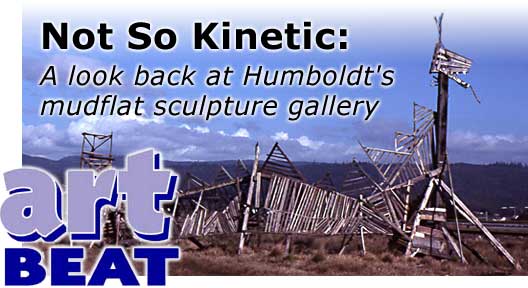
story and photos by BOB SOMMER
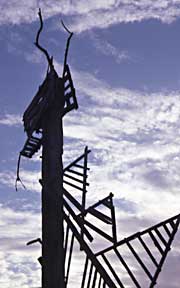 Thirty
years ago, a formidable dragon stalked the Humboldt Bay marshlands
by day and by night, its presence confirmed by thousands of motorists
driving Highway 101 between Eureka and Arcata. The creature's
height exceeded 20 feet, and a long, spiky tail brought its length
to over 30 feet. In 1979, the marsh was visited by a flying saucer
from which two green extraterrestrials disembarked. The flying
saucer departed, but the two ETs became attached to the dragon
and remained. Thirty
years ago, a formidable dragon stalked the Humboldt Bay marshlands
by day and by night, its presence confirmed by thousands of motorists
driving Highway 101 between Eureka and Arcata. The creature's
height exceeded 20 feet, and a long, spiky tail brought its length
to over 30 feet. In 1979, the marsh was visited by a flying saucer
from which two green extraterrestrials disembarked. The flying
saucer departed, but the two ETs became attached to the dragon
and remained.
Dragon at right and above, 1977. Wheel man
below, 1979.
Fabulations of a pot smoker? No way. Before the
term "outsider art" became popular, the marsh hosted
a most creative folk sculpture exhibition, one patterned after
a sister gallery on the Emeryville mudflats. Although names and
dates are lost, around Christmas time in the early '70s an anonymous
group of young people, possibly college students, came to the
marsh and built a driftwood sculpture of Jesus. The piece was
quickly torn down by an equally anonymous group, said to be "townies"
who considered the original work to be sacrilegious. The local
newspaper, not known for its interest in the arts, editorialized
against the needless vandalism, and within a few days the original
artisans returned to create additional wooden figures using material
gathered on the marsh. Apparently the newspaper editorial had
some impact, as the new work was left undisturbed, encouraging
others to come and build their own sculptures. Within a few years
the marsh became a popular driftwood gallery with a guaranteed
audience of travelers.
Unlike the flimsy constructions at Emeryville on
San Francisco Bay, often made from splintery boards and bay flotsam
and on their way to decrepitude even before completion, the local
sculptures were quite durable. Some pieces, such as the dragon
and the single-engine airplane, lasted more than five years.
Credit was due not merely to the superior construction skills
of the artisans, but to the materials available, the leavings
of the regional timber industry. Located in a less urban area
than Emeryville, the local marsh was spared the deluge of plastic
containers, styrofoam packing, inner tubes and other urban detritus
that went into San Francisco Bay. Since informal gallery rules
restricted artisans to indigenous materials, artisans on the
bay used different types of wood and bark to show variations
in color and texture. The fiery tongue of the driftwood dragon
was a manzanita branch.
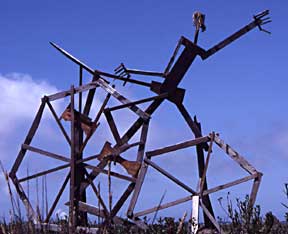 The
content of the sculpture gallery drew heavily from the surrounding
area. The bay encouraged nautical themes such as boats, whales,
dolphins and shore birds. Inspiration for the occasional wooden
airplane and helicopter can be traced to the airport across the
highway. Locale, weather and time of day, all affected the appearance
of the whimsical constructions. The driftwood airplane appeared
to have landed on a bed of ice plant. On some foggy days the
looming head of the driftwood dragon was the only thing on the
marsh visible to passing motorists. The
content of the sculpture gallery drew heavily from the surrounding
area. The bay encouraged nautical themes such as boats, whales,
dolphins and shore birds. Inspiration for the occasional wooden
airplane and helicopter can be traced to the airport across the
highway. Locale, weather and time of day, all affected the appearance
of the whimsical constructions. The driftwood airplane appeared
to have landed on a bed of ice plant. On some foggy days the
looming head of the driftwood dragon was the only thing on the
marsh visible to passing motorists.
The work was anonymous: There were no signatures
or plaques to identify the artisans. This was standard practice
in all driftwood galleries. The sculpture was made to satisfy
the creative urges of the artisans, including art classes from
nearby schools, and also to surprise and delight passing motorists.
Unlike Emeryville, there was little abstract or political art
— instead, the pieces tended to be representational and apolitical.
It's not totally clear why, but in 1986 the sculpture
garden disappeared. The marsh was a wildlife sanctuary, and some
said the constructions should never have been allowed. The marsh
had known a brief flowering of driftwood art, a period less than
15 years. The only records remaining are the artisans' memories
and the photo albums of visitors surprised to see a dragon along
a busy highway.



Mudflat Confessions
story and photos by BOB DORAN
Who were the mysterious sculptors who adorned the
mudflats between the Bracut lumberyard and the bridge into Eureka?
Bob Sommer is right in saying that their work was anonymous,
but it wasn't hard to find a couple of them: one of the artists
who built the first sculpture and another who built one of the
last.
"I did three," said Peter Brant when
I spoke with him last Saturday at the Arcata office for his businesses,
Brant Electric and Fire Arts Foundry. "One was a crucifix
with a tire for a head; that was the first. Another was a head,
just the top of it coming out of the mud with the eyes, the ears
and the nose showing."
His most famous creation was the long-lived dragon,
which he built with some friends in the early '70s. "We
based the design on the materials we found when we got there,"
said Brant. "There was a telephone pole; we stood it up
and started making humps out of the other scraps. Easy."
Brant said no authorities complained about the
guerilla art projects. "We basically did them in broad daylight
— weekends, because I was working weekdays. No one even approached
us."
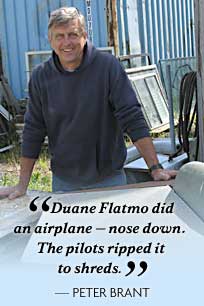 Noting
that "many others" followed in his footsteps, he said
he does not know who they were — aside from one sculptor. "Duane
Flatmo did an airplane — nose down. The pilots ripped it to
shreds; they thought it was bad luck. I think that might have
been the beginning of the end. Then [the whole area] became a
wildlife refuge. I loved the mudflat sculptures. I was sorry
to see them go." Noting
that "many others" followed in his footsteps, he said
he does not know who they were — aside from one sculptor. "Duane
Flatmo did an airplane — nose down. The pilots ripped it to
shreds; they thought it was bad luck. I think that might have
been the beginning of the end. Then [the whole area] became a
wildlife refuge. I loved the mudflat sculptures. I was sorry
to see them go."
In fact, the marshland along the highway was protected
as wildlife habitat for many years while sculptures were there.
But Brant was probably correct in assuming that Duane Flatmo's
airplane was the beginning of the end. That's how I remember
it, anyway.
After Bob Sommer's mudflat reminiscence first arrived
in my e-mail box a few weeks ago, I called Flatmo, now one of
Humboldt's most prominent artists, at least in terms of visibility.
His murals are everywhere you look, his paintings and sculptures
are shown in the best local galleries, his trademark neo-cubist
graphic style shows up on beer bottles, bags of compost and posters.
And, of course, he is among the elite pilot/designers in this
weekend's Kinetic Sculpture Race.
Flatmo related the history of his involvement in
mudflat sculpting over the phone, at least as best as he could
recall looking back 20-some-odd years. When we spoke in person
at the Kinetic Lab on Saturday, where he was putting the finishing
touches on his latest kinetic kontraption, he had a slightly
different story to tell.
"I had seen those Cadillacs buried nose down
out in the desert," he began, referring to Stanley Marsh's
famous Cadillac Ranch outside of Amarillo, Texas. "I thought,
`Why not an airplane like that?'" he continued. "I
didn't realize that people would take it as a crashed plane since
it was right across from the airport."
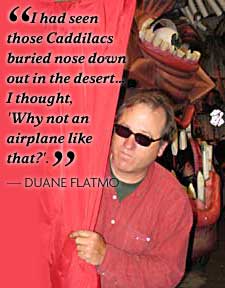 At
that point I had to stop my friend Duane and remind him that
he had previously told me that he specifically coordinated the
erection of the sculpture with the opening of an air show at
Murray Field. He had also confirmed Brant's recollection that
his airplane had been destroyed by angry pilots. He had noted
that his response was to reassemble the offending plane, only
to have it dismantled again by parties who left a threatening
note warning him against a repeat performance. At
that point I had to stop my friend Duane and remind him that
he had previously told me that he specifically coordinated the
erection of the sculpture with the opening of an air show at
Murray Field. He had also confirmed Brant's recollection that
his airplane had been destroyed by angry pilots. He had noted
that his response was to reassemble the offending plane, only
to have it dismantled again by parties who left a threatening
note warning him against a repeat performance.
He admitted his joke was a bit dark. "What
was really terrible was [a local doctor] died about a week later
when he crashed his experimental aircraft on the beach,"
he said with a note of regret. "His plane was the same shape
as the plane in the mudflats. That was a bit weird."
The experience made Flatmo decide to give up on
mudflat sculpture, but the furor he'd stirred up did not die.
"There were all these letters to the editor. I think it
was Judge Morrison who wrote, `It was like building a coffin
in front of a hospital.' Some guy who was Harbor Commissioner
told me [the sculptures were] an eyesore and all the wood out
there was going to be removed because it was a wildlife sanctuary.
They said the birds would eat the paint on the wood, and that
some [wood] was pressure-treated, that it was unfit for the habitat.
And it did get out of hand. It wasn't just my thing; there were
tons going up out there. It had become a place to make political
statements, and it got kind of trashy — along with the real
sculptures. They hauled them all away."
And thus ended a chapter in local art history.
But, you might wonder, could some mudflat phoenix ever rise again?
"Duane and I have talked about doing some
midnight sculptures since, but we never got around to it,"
Brant confided. With a big grin he concluded, "Both of us
are outlaws, but we don't want to be outlaws-in-jail. We've become
a little more conservative."



Got a local exhibit or art event
that might make a good story? Send your art news to almy@arcatanet.com
or write in care of the North
Coast Journal, 145 South G Street, Suite A, Arcata, CA. 95521.
COVER STORY | IN
THE NEWS | ARTBEAT
TALK OF THE
TABLE | THE HUM | CALENDAR
Comments? Write
a letter!

© Copyright 2006, North Coast Journal,
Inc.
|